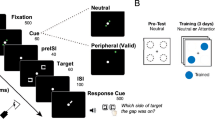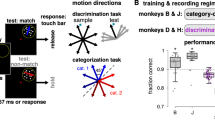Abstract
Visual position discrimination improves with practice; however, the mechanism(s) underlying this improvement are not yet known. We used positional noise to explore the underlying neural mechanisms and found that position discrimination improved with practice over a range of noise levels. This improvement can be largely explained by an increasing efficiency with which observers used positional information in the stimulus. In a second experiment, we tested the hypothesis that the improved efficiency reflects a re-tuning of the observers' perceptual 'template'—the weightings of inputs from basic visual mechanisms—to more closely match the ideal template required to perform the perceptual task. Using a new technique to measure which parts of the stimulus influenced the observer's performance, we were able to record the re-tuning of the decision template across training sessions; we found a robust and steady increase in template efficiency during learning.
This is a preview of subscription content, access via your institution
Access options
Subscribe to this journal
Receive 12 print issues and online access
$209.00 per year
only $17.42 per issue
Buy this article
- Purchase on Springer Link
- Instant access to full article PDF
Prices may be subject to local taxes which are calculated during checkout






Similar content being viewed by others
References
Fiorentini, A. & Berardi, N. Perceptual learning specific for orientation and spatial frequency. Nature 287, 43–44 (1980).
Vogels, R. & Orban, G.A. The effect of practice on the oblique effect in line orientation judgements. Vision Res. 25, 1679–1687 (1985).
Fahle, M. & Morgan, M. No transfer of perceptual learning between similar stimuli in the same retinal position. Curr. Biol. 6, 292–297 (1996).
McKee, S.P. & Westheimer, G.W. Improvement in vernier acuity with practice. Percept. Psychophys. 24, 258–262 (1978).
O'Toole, A.J. & Kersten, D.J. Learning to see random-dot stereograms. Perception 21, 227–243 (1992).
Ball, K. & Sekular, R. A specific and enduring improvement in visual motion discrimination. Science 218, 697–698 (1982).
Schoups, A.A. & Orban, G.A. Interocular transfer in perceptual learning of a pop-out discrimination task. Proc. Natl. Acad. Sci. USA 93, 7358–7362 (1996).
Furmanski, C.S. & Engel, S.A. Perceptual learning in object recognition: object specificity and size invariance. Vision Res. 40, 473–484 (2000).
Gold, J., Bennett, P.J. & Sekuler, A.B. Signal but not noise changes with perceptual learning. Nature 402 (1999).
Dosher, B.A. & Lu, Z.L. Perceptual learning reflects external noise filtering and internal noise reduction through channel reweighting. Proc. Natl. Acad. Sci. USA 95, 13988–13993 (1998).
Dosher, B.A. & Lu, Z.L. Mechanisms of perceptual learning. Vision Res. 39, 3197–3221 (1999).
Poggio, T., Fahle, M. & Edelman, S. Fast perceptual learning in visual hyperacuity. Science 256, 1018–1024 (1992).
Fahle, M., Edelman, S. & Poggio, T. Fast perception learning in hyperacuity. Vision Res. 35, 3003–3013 (1995).
Fahle, M. & Edelman, S. Long-term learning in vernier acuity: Effects of stimulus orientation, range and of feedback. Vision Res. 33, 397–412 (1993).
Wang, H., Levi, D.M. & Klein, S.A. Intrinsic uncertainty and integration efficiency in bisection acuity. Vision Res. 36, 717–739 (1996).
Levi, D.M., Klein, S.A. & Carney, T. Unmasking the mechanisms for Vernier acuity: evidence for a template model for Vernier acuity. Vision Res. 40, 951–972 (2000).
Saarinen, J. & Levi, D.M. Perceptual learning in vernier acuity: What is learned? Vision Res. 35, 519–527 (1995).
Levi, D. & Klein, S.A. The role of sepration and eccentricity in encoding position. Vision Res. 30, 557–585 (1990).
Green, D.M. Consistency of auditory detection judgments. Psychol Rev. 71, 392–407 (1964).
Zeevi, Y.Y. & Mangoubi, S.S. Vernier acuity with noisy lines: estimation of relative position uncertainty. Biol. Cybern. 50, 371–376 (1984).
Pelli, D.G. The quantum efficiency of vision. in Vision: Coding and Efficiency (ed., Blakemore, C.) 3–25 (Cambridge Univ. Press, Cambridge, 1990).
Carkeet, A., Levi, D.M. & Manny, R.E. Development of Vernier acuity in childhood. Optom. Vis. Sci. 74, 741–750 (1997).
Beard, B.L. & Ahumada, A.J. A technique to extract relevant image features for visual tasks. Proc. Hum. Vis. Electronic Imaging III SPIE 3299, 79–85 (1998).
Levi, D.M. & Klein, S.A. Classification images for detection and position discrimination in the fovea and parafovea. J. Vis. 2, 46–65 (2002).
Murray, R.F., Bennett, P. & Sekuler, A.B. Optimal methods for calculating classification images: weighted sums. J. Vis. 2, 79–104 (2002).
Ahumada, A.J. Classification image weights and internal noise level estimation. J. Vis. 2, 121–131 (2002).
Gold, J.M., Murray, R.F., Bennett, P.J. & Sekuler, A. Deriving behavioural receptive fields for visually completed contours. Curr. Biol. 10, 663–666 (2000).
Lu, Z.L., Lesmes, L.A. & Dosher, B.A. Spatial attention excludes external noise at the target location. J. Vis. 2, 312–323 (2002).
Gold, J.M., Sekuler, A.B. & Bennett, P.J. Visualizing perceptual learning. Cogn. Sci. (in press).
Solomon, J.A. Noise reveals visual mechanisms of detection and discrimination. J. Vis. 2, 105–120 (2002).
Gilbert, C.D. & Wiesel, T.N. Receptive field dynamics in adult primary visual cortex. Nature 356, 150–152 (1992).
Chino, Y.M., Kaas, J.H., Smith, E.L.I., Langston, A.L. & Cheng, H. Rapid reorganization of cortical maps in adult cats following restricted deafferentation in retina. Vision Res. 32, 789–796 (1992).
Skrandies, W., Lang, G. & Jedynak, A. Sensory thresholds and neurophysiological correlates of human perceptual learning. Spat. Vis. 9, 475–489 (1996).
Skrandies, W., Jedynak, A. & Fahle, M. Perceptual learning: psychophysical thresholds and electrical brain topography. Int. J. Psychophysiol. 41, 119–129 (2001).
Schoups, A., Vogels, R., Qian, N. & Orban, G. Practising orientation identification improves orientation coding in V1 neurons. Nature 412, 549–553 (2001).
Ghose, G.M., Yang, T. & Maunsell, J.H. Physiological correlates of perceptual learning in monkey V1 and V2. J. Neurophysiol. 87, 1867–1888 (2001).
Schiltz, C. et al. Neuronal mechanisms of perceptual learning: changes in human brain activity with training in orientation discrimination. Neuroimage 9, 46–62 (1999).
Kassubek, J., Schmidtke, K., Kimmig, H., Lucking, C.H. & Greenlee, M.W. Changes in cortical activation during mirror reading before and after training: an fMRI study of procedural learning. Brain Res. Cogn. Brain Res. 10, 207–217 (2001).
Herzog, M.H. & Fahle, M. The role of feedback in learning a vernier discrimination task. Vision Res. 37, 2133–2141 (1997).
Wickens, T.D. Elementary Signal Detection Theory (Oxford Univ. Press, New York, 2002).
Ahumada, A.J. & Lovell, J. Stimulus features in signal detection. J. Acoust. Soc. Am. 49, 1751–1756 (1971).
Acknowledgements
This work was supported by research grants R01EY01728 and R01EY04776 from the National Eye Institute. The authors thank E. Bassett, S. Gepshtein, A. Popple, J. Saarinen, K. Young and E. Wong for their comments on an earlier version of the manuscript.
Author information
Authors and Affiliations
Corresponding author
Ethics declarations
Competing interests
The authors declare no competing financial interests.
Rights and permissions
About this article
Cite this article
Li, R., Levi, D. & Klein, S. Perceptual learning improves efficiency by re-tuning the decision 'template' for position discrimination. Nat Neurosci 7, 178–183 (2004). https://doi.org/10.1038/nn1183
Received:
Accepted:
Published:
Issue Date:
DOI: https://doi.org/10.1038/nn1183
This article is cited by
-
Learning to optimize perceptual decisions through suppressive interactions in the human brain
Nature Communications (2019)
-
Heart Rate Variability and Cardiopulmonary Dysfunction in Patients with Duchenne Muscular Dystrophy: A Systematic Review
Pediatric Cardiology (2018)
-
The equivalent internal orientation and position noise for contour integration
Scientific Reports (2017)
-
Mixture of easy trials enables transient and sustained perceptual improvements through priming and perceptual learning
Scientific Reports (2017)
-
Monocular perceptual learning of contrast detection facilitates binocular combination in adults with anisometropic amblyopia
Scientific Reports (2016)



